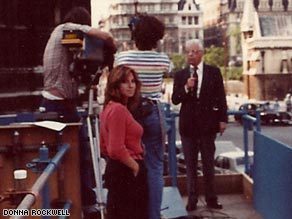
Finding moments for mindfulness practice in the journalist’s workday. Producing for CNN Senior Correspondent, Daniel Schorr, in London, 1982.
The landscape of the journalist’s workday has changed considerably since I was active in the field. I worked for CNN, starting in June 1980 in the Washington, D.C. bureau, where I was starry-eyed like Jimmy Olsen and no-nonsense, like Lois Lane. I wanted to make a difference, like Woodward and Bernstein. As it turned out, I bore witness to many historic moments: producing from the White House when the Hostages came home, covering Ronald Reagan’s historic trip to Checkpoint Charlie at the Berlin Wall, and spending marathon hours following Iran-Contra hearings on Capitol Hill.
While I blog these days and am interviewed by reporters about psychological questions they may have, I am not a journalist anymore. I am a clinical psychologist specializing in mindfulness. In fact the maddening pace of journalism is the very thing that sent me, with anxiousness and a racing mind, to a meditation cushion in the first place, and revealed a world that made all the stressors and lifestyle challenges that journalists by necessity face somehow manageable. This new world I discovered was the world of mindfulness.
In the 1980s, it was high stakes enough to work for one news outlet on one news package a day. I can't even imagine in these volatile times the stress of reporting on various cable news shows and posting through social media 24 hours a day. A recent study reported in BusinessInsider.com examined how journalists deal with all this stress. The study’s authors investigated lifestyle, health, and behavior among 40 newspaper, magazine, broadcast and online journalists over seven months, and found that not only are journalists “bad at managing emotions” and “operate at a lower level than average,” but also that they scored low on “silencing the mind, which is related to the ability to have thoughts without getting distracted by them, or a powerful ability to focus.” Researchers said that low scores indicate that, by and large, “journalists have a hard time preventing themselves from worrying about the future or regretting the past.” Journalism, however, requires presence.
Fortunately, I am here to report that mindfulness, in my opinion, remains the best way for today’s journalists to cope with their increased stress levels, and learn how to stay present without being swept away. After all, mindfulness is the ability to notice past-or-future worries, but then, through the cultivation of certain mindfulness skills, to let such ruminations go in order to return to awareness of RIGHT NOW, a very important ability for media types subject to the onslaught of constant workplace pressures, obstacles, and deadlines.
While journalists in the study complained they had no time for breaks, mindfulness practices can be undertaken at various naturally-arising opportunities during the day. Taking advantage of those opportunities could very well contribute to increased physical and emotional wellness, as well as greater reportorial accuracy.
Here is a brief mindfulness exercise that can be practiced anywhere. While waiting at stakeouts, for 30-seconds or so before writing a script, or even when taking a moment in the bathroom, this exercise acts to settle the mind, like sand coming to rest in a glass of water, creating a pause in the staccato and cacophonous thoughts that often seem to overtake us. When practiced in the morning before jumping out of bed, or at night when trying to sleep, mindfulness can alter brain activity and neurological function in ways that can inoculate us against the compounding nature of stress. Remember: In peace, there is wisdom.
Sitting upright and comfortably, place your hands open-palmed, one on the heart area of the chest and one on the belly. With eyes closed or with eyes open (whichever is more comfortable), feel the breath coming into the body through the nostrils, and out of the body through the nostrils. Like a self-hug, feel the chest and belly rising with each inhaled breath, and then falling with each gentle exhalation, expanding and contracting. Continue for several breaths.
By gently following the breath, this short mindfulness practice allows for an experience of union between the rising and falling of the breath—feeling the breath entering the body, and then released in a long, slow out-breath that dissolves into space. This allows the mind to relax. When ready, return to your normal activities.
While it may seem antithetical for a busy reporter, or camera person, or news editor to consider working from a center of peacefulness grounded in the here-and-now, it is actually rather advantageous. A less cortisol-fueled mindset contributes to journalistic efficacy in the same way it leads to efficacy in every other field, by giving us greater control of our own mental processes, mood state, and presence. By engaging a mindful approach we are operating from our prefrontal cortex (executive functioning, logical reasoning, calming hormones, and the like) versus our amydgala (with its fight-flight-freeze response), a life-threatening cortisol-and-adrenaline pumping machine that can hijack our nervous system.
It is easy to see that there is no time more perfect than the current news cycle to start using easily applied mindfulness exercises, taking mere moments, practically implemented throughout the workday, These tiny pauses—like the riding-the-breath exercise—can make all the difference in the world, in: measurable improvement in self-care and wellness, cardio-vascular health, ability to cope with the stress-response, greater personal and professional insight, better lifestyle choice-making, and a sense of inner peace and well-being in the midst of all the chaotic activity integral to news-in-the-making.
I may not be a full-time journalist anymore. But I know that mindfulness is just what the doctor ordered.
Rockwell, D. & Valle, R. (2016). Mindfulness as Therapy: How Buddhist psychology contributes to enhancing therapist efficacy and client outcomes, in The Changing Faces of Therapy: Evolving perspectives in clinical practice and assessment (Ron Valle, Ed.), San Francisco, CA: Argosy University.
For more information on mindfulness for personal and professional development visit mindfulcure.com, and follow Dr. Rockwell on Facebook and Twitter.
